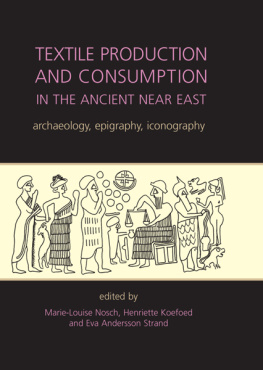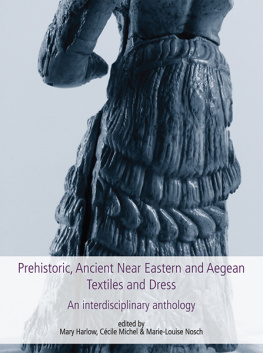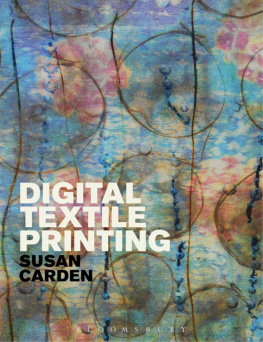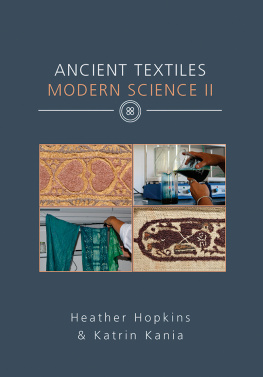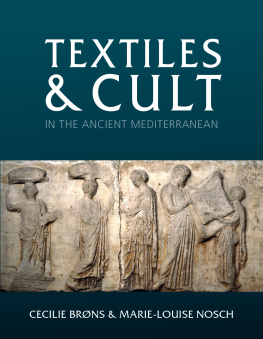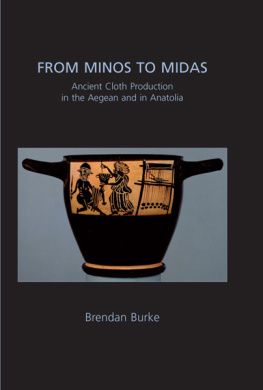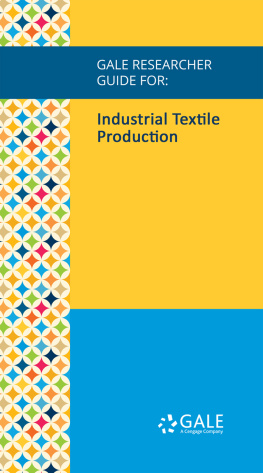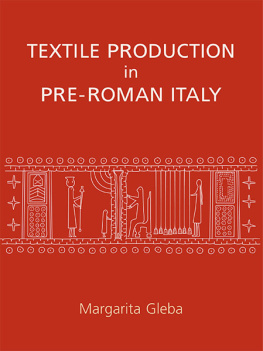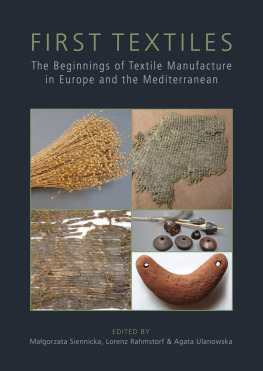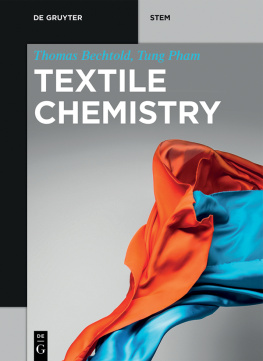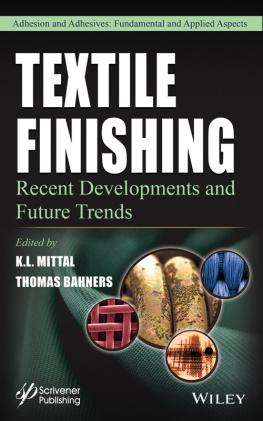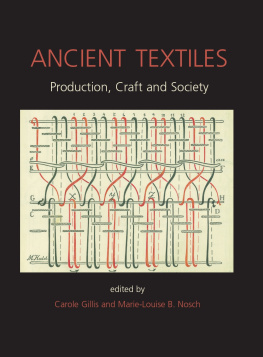Published by
Oxbow Books, Oxford, UK
Oxbow Books and the individual authors 2013
ISBN 978-1-84217-489-0
EPUB ISBN: 978-1-78297-111-5
PRC ISBN: 978-1-78297-112-2
This book is available direct from
Oxbow Books, Oxford UK
and
The David Brown Book Company
PO Box 511, Oakville, CT 06779, USA
(Phone: 860-945-9329; Fax: 860-945-9468)
or via our website
www.oxbowbooks.com
A CIP record for this book is available from the British Library
Library of Congress Cataloging-in-Publication Data
Textile production and consumption in the ancient Near East : archaeology, epigraphy, iconography / edited
by M.-L. Nosch, H. Koefoed and E. Andersson Strand. -- 1st [edition].
pages cm -- (Ancient textiles series ; vol. 12)
Includes bibliographical references.
ISBN 978-1-84217-489-0
1. Textile industry--Middle East--History. 2. Textile fabrics, Ancient--Middle East. 3. Copper age--Middle
East. 4. Bronze age--Middle East. 5. Iron age--Middle East. I. Nosch, Marie-Louise, editor of compilation. II.
Koefoed, H. editor of compilation. III. Strand, Eva B. Andersson, editor of compilation.
TS1413.5.T48 2013
338.476770956--dc23
2012039276
Front Cover: Line drawing of CS 704 by Agnete Wisti Lassen. The drawing highlights clothing and textiles.
Ancient Textiles Series Editorial Committee:
Eva Andersson Strand, Ulla Mannering, Margarita Gleba and Marie-Louise Nosch, editor
Printed in Great Britain by
Short Run Press, Exeter
Contents
by Henriette Koefoed, Eva Andersson Strand and Marie-Louise Nosch |
by Catherine Breniquet |
by Janet Levy and Isaac Gilead |
by Nurith Goshen, Assaf Yasur-Landau and Eric H. Cline |
by David R. A. Lumb |
by Agnete Wisti Lassen |
by Allison Karmel Thomason |
by Eva Andersson Strand and Maria Cybulska |
by Bernice Jones |
by Richard Firth |
by Joanna S. Smith |
by Caroline Sauvage |
by Laura B. Mazow |
by Salvatore Gaspa |
Introduction:
Archaeology, Epigraphy, Iconography
Textile is attested for more than 10,000 years in the Ancient Near East. During the Bronze Age textile production developed from household production to standardised, industrialised, centralised production. In order to visualize how textile research can contribute to a better understanding of ancient societies, the workshop Textile Production in the Ancient Near East Neolithic, Bronze Age, Iron Age given at the 7th International Congress on the Archaeology of the Ancient Near East at the British Museum in April 2010 was organised by the Danish National Research Foundations Centre for Textile Research, University of Copenhagen. During the workshop, interesting and well performed presentations were given by specialists in this research field. Furthermore, the workshop attracted a large audience and the discussions that followed the presentations were constructive, intense and scientifically well articulated. Many questions were raised and it was the impression of the organisers that a publication on these topics could contribute to a better understanding of textiles and textile production in the Ancient Near East. Additionally, it is important to analyse and discuss all the parameters of the technology and the development of textiles, their impact on society, and how textile tools and technology developed in this region. Thus, by combining epigraphic, iconographic and archaeological evidence with research on textile technology there is potential for discussion of the economic, social, and cultural impact of textiles on ancient society. In this publication several approaches are combined: textile tool studies, experimental testing, context studies and epigraphic as well as iconographical studies. The aim is first and most importantly to raise awareness of the existence of textiles and the importance of textile production and how it influenced early societies in this region. Furthermore the aim is also to demonstrate how, by combining different sources, new and important knowledge for the understanding of past can be obtained. Seventeen scholars have contributed in 13 articles. All these articles are written with different perspectives and aims but with one common thread to visualize textile and textile production in Ancient Near East.
In his article Textile, Value and Early Economics of North Syria and Anatolia, David R. A. Lumb demonstrates the importance of a theoretical approach and an essential source critical awareness. Further he introduces the reader to the importance of applying the concept of economic and symbolic value but foremost the operational value when discussing archaeological textiles, textile tools and production of textiles in written sources. Via this approach and focus on production and consumption of textiles, the textiles economic and socio-political significance can be highlighted during ancient times. For example, he suggests that with these perspectives one can question the traditional modes of independent and attached production in North Syria and Anatolia.
Janet Levi and Isaac Gilead, in their joint paper The Emergence of the Ghassulian Textile Industry in the Southern Levant Chalcolithic Period (c. 45003900 BCE), combine archaeological explorations and experimental archaeology. It is a truly interdisciplinary work containing tool studies, textile studies, contexts and an experimental part combined with ethnographic data. The interesting contribution is their aim to calculate and quantify the work process of linen fabrics in terms of labor, skill and time consume. The discussion of spindle whorls and loom weights at various Chalcholithic sites is confronted with the textiles from the Caves of Treasure and Cave of Warrior dated to 5th and 4th mill. The abundance of Chalcolithic textiles emphasizes how this craft is solidly established in the Chalcholithic era. This brings about the interesting observation that the Chalcholithic textiles have remains of sewing but no needle have ever come to light in the relevant Chalcholithic excavations. This enlightens how quite simple textile tools can be used for making quite complex textiles of considerable sizes and quantities. The authors conclude that a household economy can potentially provide all the necessary skill, tools and labor to produce Chalcholithic fabrics. Attached and specialised crafts people are not necessary to produce these complex fabrics.
How can scholars from a different research area contribute to a better understanding of written texts concerning textiles? In Visualising ancient Textiles How to make a Textile visible on the Basis of an Interpretation of an Ur III Text, Eva Andersson Strand and Maria Cybulska are discussing textile technology. Via ethnographic knowledge of textile craft, experimental textile archaeology and mathematic calculations they conclude that all the information given in the text is realistic: it is actually a description of how this textile was going to be produced, how long it took to make and finally how much raw material was used.
In his paper Considering the Finishing of Textiles based on Neo-Sumerian Inscriptions from Girsu, Richard Firth shows how detailed information on the production of fulled textiles can be extracted from the Girsu tablets. By combing analyses of the texts with knowledge of different fulling processes and he discusses how different types of textiles can be related to the various process. For example, that more man-power and material such as oil and alkali are needed when fulling a high quality textile than for a low quality textile.
Next page
